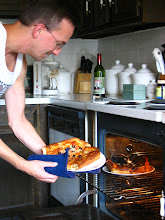Those of you unfamiliar with the 80/20 Rule, feel free to take a quick look at my original article on the subject. I'll wait.
Let me add that although I use "80%" and "20%" in these examples below, these numbers are meant only to be rough approximations. The point is not that exactly 80% of the results come from exactly 20% of the inputs. In fact, the relationship between the two variables could be lower (50% of the results come from 30% of the inputs, let's say), or much much higher (99% of the results come from 5% of the inputs). It doesn't really matter if it's 80/20, 99/5, or 50/30--in all of these cases there is a highly non-linear relationship between a system's inputs and outputs.
Thinking about the world in this way can get pretty intoxicating--after a while you start to think you can fix anything with just a tweak of a couple of "critical few" inputs. Of course, that's a gross oversimplification of reality. But nevertheless, this exercise has been an eye-opener for me in how seemingly small changes in my habits can have substantial results.
So let's explore still more applications of 80/20 thinking as they apply to diet, food and cooking. And if you can think of any additional examples that you'd like to add, please share them in the comments section below!
**********************************
Diet Issues:
1) 80% of your calories will likely come from 20% of the foods you eat. Thus if you cut out those foods, you can substantially reduce your caloric intake. Sorry, but cutting out dark chocolate is not an option.
2) The bulk of your excess calories are likely to come from a surprisingly small number of sessions of serious overeating. Or overdrinking.
3) You will likely find that 80% of your "bad eating" can be significantly reduced by changing one or two key eating habits (e.g., don't eat in front of the TV, or don't eat out of the bag/box/carton).
4) Here's a slightly different way to think about this: 80% of the "bad things" in your diet (fat, cholesterol, empty calories, etc.) are likely to come from 20% of the foods you eat. Furthermore, 80% of the good things you eat (fiber, antioxidants, lean protein, etc), come from 20% of the foods you eat. Thus you can dramatically alter the overall health content of your diet by tweaking a few inputs on both sides of the ledger.
Managing Food Costs:
1) 20% of the ingredients you buy will end up in 80% of your recipes. If you can carefully manage the cost of those ingredients, you should be able to slash your food bill materially (props to CheapHealthyGood for helping me think of this one).
2) Likewise, consider taking inventory of those critical few ingredients that are common to most of the dishes you cook. Buying them exclusively in bulk will save you more money still.
3) 80% of the cost of the food you eat will come from approximately 20% of your food items. Therefore, if you want to spend a lot less on food, you can do so by cutting back on just a few very expensive items in the grocery store.
Food Waste:
1) 80% of your food waste will come from a very small number of foods that you buy, or will be a results of very few dishes that you cook. Identify those dishes or those foods and address the problems, and you'll be able to dramatically reduce the amount of waste in your kitchen (props to thekitchn for spurring me to think of this one).
Cooking:
1) You can likely exploit your "critical few' cookbooks much more effectively by trying every single recipe in those cookbooks.
2) It's likely that 20% of your recipes will require a disproportionately wide range of ingredients. Unless those are family favorites, you can vastly simplify your kitchen pantry by cutting those recipes out of your cooking rotation.
3) Remember that you use 20% of your cooking tools to do 80% of your cooking. This implies that you will rarely use the vast majority of all cooking gadgets you buy. Therefore, be extremely selective when purchasing new kitchen items. Don't waste your money on things that will end up collecting dust.
4) Instead, consider paying up for heavy-use items like a really good kitchen knife set. It will be a much more worthwhile investment than spending money on the next incremental cooking gadget that catches your eye.
What are other examples of 80/20 thinking that you've used in your home?
Related Posts:
How to Apply the 80/20 Rule to Cooking
Seven Ways to Get Faster at Cooking
How to Team Up in the Kitchen
Capitalize on Your Cooking Core Competencies
How can I support Casual Kitchen?
If you enjoy reading Casual Kitchen, tell a friend and spread the word! You can also support me by purchasing items from Amazon.com

No comments:
Post a Comment